 Image search results - "hikone" Image search results - "hikone" |
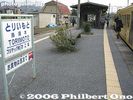
Toriimoto-juku is the sixty-third of the sixty-nine stations or shukuba post towns on the Nakasendo Road. It is the fourth Nakasendo station in Shiga (following Bamba-juku in Maibara), and one of ten Nakasendo stations in Shiga.
|
|
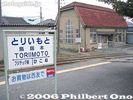
Although the Honjin is long gone, there are a few reminders of its shukuba past. Near Ohmi Railways Toriimoto Station. Map
|
|
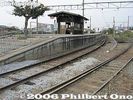
Ohmi Railways Toriimoto Station platform
|
|

Ohmi Railways Toriimoto Station building
|
|

Ohmi Railways Toriimoto Station building
|
|
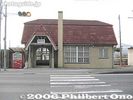
Toriimoto Station building built in 1931 when the station opened and still in use.
|
|
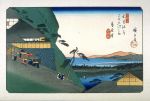
Hiroshige's woodblock print of Toriimoto (64th post town on the Nakasendo) from his Kisokaido series.
|
|

Toriimoto-juku is the sixty-third of the sixty-nine stations or shukuba post towns on the Nakasendo Road. It is the fourth Nakasendo station in Shiga (following Bamba-juku in Maibara), and one of ten Nakasendo stations in Shiga.
|
|
|
|
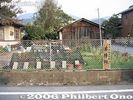
Site of Honjin Lodge
|
|
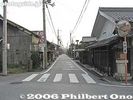
Nakasendo Road
|
|
|
|
|
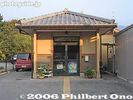
Police station
|
|
|
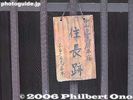
Plaque
|
|
|
|
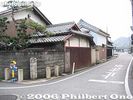
Road marker
|
|
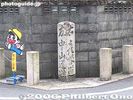
Road marker: Go left for the Nakasendo Road or right for the Hikone Road.
|
|
|
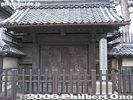
Yakuimon Gate at the Arikawa machiya home. Emperor Meiji rested at the Arikawa home. A family still lives in this home. 有川家住宅 薬医門
|
|
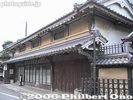
Main building of the Arikawa home, Toriimoto's most distinguished-looking building. This main building was built in 1759. The Arikawa family were a drug manufacturer. The home was designated as an Important Cultural Property in 2012.
|
|
|

Verse 5 Lyrics (Hikone) 五番の英訳(彦根)Sharp arrows buried deeply, way into the ground.
Abundant summer grasses, a moat still remains.
Standing in an old castle, all alone oneself.
Hira and Ibuki too, only but a dream.
矢の根は 深く埋もれて
夏草しげき 堀のあと
古城にひとり 佇めば
比良も伊吹も 夢のごと
Ya no ne wa, fukaku uzumorete
Natsukusa shigeki, hori no ato
Kojo ni hitori, tatazumeba
Hira mo Ibuki mo, yume no goto
--
This is the only verse where the setting is not specifically mentioned. The only hint is "old castle," which must be either Nagahama Castle or Hikone Castle. It is likely that it is Hikone Castle with its authentic castle tower and moats.
See more photos of Hikone here.
|
|

"Abundant summer grasses, a moat still remains"
|
|
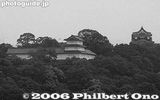
Hikone Castle
|
|
|
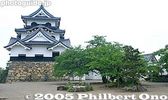
More photos of Hikone Castle here.The castle tower is a National Treasure. Hikone Castle is one of only five castle towers in Japan designated as National Treasures. (The others being Himeji, Inuyama, Matsumoto, and Matsue Castles. Nijo Castle in Kyoto is also a National Treasure, but it does not have a castle tower.)
See more photos of Hikone Castle here.
|
|

The 2nd Yuru-kyara festival was held in Oct. 23-25, 2009. The festival was expanded by a day by including an indoor stage show featuring enka singer Hashi Yukio singing "Yuru-kyara Ondo."On Oct. 23, 2009 (Fri.), the Yuru-kyara Daishugo event was held at the Hikone Bunka Plaza's Grand Hall. ひこね市文化プラザ グランドホール
|
|

Hikone Bunka Plaza's Grand Hall. Still photography was permitted, but no videos and tripods. The event was a stage show of all the mascot characters appearing on stage. They held three shows on this day. ひこね市文化プラザ グランドホ�
|
|

I attended the 3 pm show which was the only show when famous singer Hashi Yukio would appear and sing with the mascot characters. Admission was 1,000 yen. ゆるキャラ大集合
|
|

First they introduced Shiga's mascot characters including Hiko-nyan.
|
|

Shiga's mascot characters
|
|

Then they introduced Miura Jun (right), the man who coined the word "yuru-kyara."
|
|

Then the curtain was lifted to show all the mascot characters as the audience began snapping pictures in a frenzy.
|
|

Yuru-kyara mascot characters on stage in Hikone, Shiga Prefecture.
|
|
|
|
|
|
|

Singer Hashi Yukio then appeared on stage.
|
|

Some talking between Hashi and Miura. (The woman is the MC.)
|
|

Hashi Yukio sings the "Yuru-kyara Ondo" in front of Yuru-Kyara characters in Hikone, Shiga Prefecture.
|
|

Hashi Yukio sings the "Yuru-kyara Ondo" in front of Yuru-Kyara characters in Hikone, Shiga Prefecture.
|
|

Hashi Yukio even danced with a few mascot characters.
|
|

Hashi Yukio
|
|

Hashi Yukio sings in front of Yuru-Kyara characters in Hikone, Shiga Prefecture. He sang a few numbers.
|
|
|

And there they are on stage in Hikone. Notably absent was Sento-kun from Nara. (Boy priest with antlers.)
|
|
|
|

Hiko-nyan and mouse.
|
|
|
|
|
|

Tabimaru from Kusatsu, Shiga.
|
|
|
|
|
|
|
|
|
|

Hashi Yukio's "Yuru-Kyara Ondo" CD was also on sale in the hall lobby as well as Yuru-kyara books autographed by Miura Jun.
|
|

Meanwhile, outside the Hikone Bunka Plaza Hall were hordes of people crowding around the mascot characters.
|
|
|
|

Two catfishes: Magnee (Shiga Lakestars mascot) and Caffy (sports mascot).
|
|

Food mascots
|
|
|

Pig
|
|
|
|
|
|
|
|
|
|
|
|
|
|

Mori from Moriyama, Shiga
|
|

Ninjaemon ninja mascot from Koka, Shiga
|
|
|
|
|

Mailman
|
|
|
|
|

Inflatable mascot
|
|

One of many cats.
|
|
|

Musubi-maru to promote tourism in Sendai, Miyagi Pref. Rice ball modeled after Lord Date Masamune. むすび丸 (宮城 仙台市)
|
|
|
|
|
|

Turbo-kun based on pop singer Takanori Nishikawa of T.M. Revolution who hails from Shiga Prefecture. He is an official tourism ambassador for Shiga.
|
|

During the weekend of Oct. 24-25, 2009 on Yume-Kyobashi Castle Road near Hikone Castle, the mascot character festival was held amid product PR booths. ゆるキャラ ふれあい物産展
|
|

Hardly anyone patronized the booths. Everyone was busy chasing after and photographing numerous mascot characters. Over 70,000 people attended the festival during the three days. 夢京橋キャッスルロード
|
|
|

They had a lot more mascot characters than the previous year.
|
|
|
|

Kabuki-like
|
|

Otsu Hikaru-kun from Otsu, Shiga to promote the 1000th anniversary in 2008 of the novel Genji Monogatari written in Ishiyama-dera temple in Otsu. おおつ光ルくん (滋賀 大津市)
|
|

Sagawa family of mascots from Sagawa Art Museum in Moriyama, Shiga.
|
|

Official mascots of Maibara, Shiga Prefecture. A pair of fireflies.
|
|

Mama firefly from Maibara
|
|

Hiko-nyan arrives on a cart pulled by bicycle. He didn't stop and kept going.
|
|

Hiko-nyan is the most popular character, but he was least seen and not available to the public. No one could get close.
|
|

Takumi Ponzan, a tanuki potter mascot from Shigaraki, Koka, Shiga
|
|

The Azai sisters. On the left is Chacha-hime, based on the eldest daughter Chacha (later Lady Yodo-dono) of Lord Azai Nagamasa and Oichi (sister of Oda Nobunaga) who lived in Odani Castle in Kohoku-cho. Middle is Hatsu, and Go on the right. 茶々姫
|
|

Vivace-kun is a beaver promoting Viva City shopping mall in Hikone, Shiga. ビバッチェくん (滋賀 彦根市)
|
|

Tabi-maru. a traveler character from Kusatsu, Shiga. Kusatsu was a crossroads on the old Tokaido and Nakasendo Roads where many travelers lodged. "Tabi" means "travel." たび丸 (滋賀 草津市)
|
|

On Oct. 25-26, 2008, the first Yuru-Kyara (Mascot Character) Matsuri was held on Yume-Kyobashi Castle Road in Hikone. This sign at Hikone Station points the way. Map
|
|

Yume-Kyobashi Castle Road was closed off to traffic for this festival. First they were going to hold the festival at a shopping center, but switched to this place after realizing how popular the event would be.
|
|

The road was lined with PR booths for each mascot. They promoted products or tourism. The event saw about 46,000 visitors during the two days. The festival's official Web site is here.
|
|

About 46 mascots showed up during the two days. I went on the first day. They are called "yuru-kyara" (ゆるキャラ) in Japanese which means "loose characters." (Don't ask me what that means.)
|
|

Namu-kun from Nara to celebrate the 1300th anniversary of Nara. "Namu" is based on "Namu Amida butsu" and "Namu Horengekyo." なーむくん (奈良 奈良市)
|
|

Namu-kun is modeled after Shotoku Taishi who introduced Buddhism to Japan. Created by a Buddhist association in Nara in opposition to Sento-kun (see below). But Namu-kun and Sento-kun played together at this festival in peace.
|
|

Otsu Hikaru-kun from Otsu, Shiga to promote the 1000th anniversary in 2008 of the novel Genji Monogatari written in Ishiyama-dera temple in Otsu. おおつ光ルくん (滋賀 大津市)
|
|

Kamon-chan is a princess created by students at Shiga Univ. for Ii Naosuke and the 150th anniversary of Japan's opening to the world. カモンちゃん (滋賀 彦根市)
|
|

Humanoid mascots were the most numerous. This is Chacha-hime, based on the eldest daughter Chacha (later Lady Yodo-dono) of Lord Azai Nagamasa and Oichi (sister of Oda Nobunaga) who lived in Odani Castle in Kohoku-cho. 茶々姫
|
|

Yoemon-kun, the mascot for the 400th anniversary of the birth of Confucian scholar Nakae Toju from Takashima, Shiga Pref. よえもん君 (滋賀 高島市)
|
|

Musubi-maru to promote tourism in Sendai, Miyagi Pref. Modeled after Lord Date Masamune. むすび丸 (宮城 仙台市)
|
|

Toshinaga-kun to promote the 400th anniversary of Takaoka, Toyama Pref. Based on Lord Maeda Toshinaga. 利長くん (富山 高岡市)
|
|

Who's this baby wandering around Yonbancho shopping center?
|
|

A baby sumo wrestler?
|
|

Tabi-maru. a traveler character from Kusatsu, Shiga. Kusatsu was a crossroads on the old Tokaido and Nakasendo Roads where many travelers lodged. "Tabi" means "travel." たび丸 (滋賀 草津市)
|
|

Chikamon-kun from Sabae, Fukui Pref. Modeled on Chikamatsu Monzaemon for his 345th birthday. ちかもんくん (福井 鯖江市)
|
|

A tall Tsunuga-kun from Tsuruga, Fukui Pref. To celebrate the Tsuruga's 100th anniversary of its port opening. The mascot is based on a Korean prince. Many ships plied between Tsuruga and the Korean Peninsula. ツヌガくん (福井 敦賀市)
|
|

Yanana was the weirdest and least mascot-like. It's actually a mermaid and she danced around the place, shaking her hips. Promoted Yanagase Shopping Arcade in Gifu city. Her head is shaped like an arcade. やなな (岐阜 岐阜市柳ヶ瀬商店街�
|
|

The main draw by far was Sento-kun from Nara. The place had two small stages where they introduced each mascot. A huge crowd gathered to see Sento-kun appear on stage.
|
|

Everyone snap away with their camera phones when Sento-kun got on stage.
|
|

Introducing Sento-kun.
|
|

Sento-kun, a boy priest with deer antlers to promote the 1300th anniversary of Nara. せんとくん (奈良 奈良市)
|
|

Sento-kun was controversial because people thought the deer antlers were an insult to the Buddha. This controversy has ironically made this mascot the most popular and famous.
|
|

PR booth for Sento-kun and Nara.
|
|

After the stage appearance, Sento-kun appeared in front of his PR booth on the street. A huge crowd again formed to see him.
|
|

Sento-kun in front of his PR booth ogled by a large crowd. We couldn't touch him.
|
|
|

"So what do you think of Sento-kun?" This event made news headlines on TV and in the newspapers.
|
|

Hiko-nyan did not walk around the road. He only appeared on stage as an "escort" for the mascots being introduced every 15 min. all day.
|
|

Hiko-nyan, the King of yuru-characters in Japan, and Tawawa-chan.
|
|

Shimasako-nyan, a cat based on one of Ishida Mitsunari's retainers. しまさこにゃん、ひこね「街の駅」寺子屋 力石マスコットキャラクター
|
|

Cat mascots were numerous.
|
|

Saba-tora Nana-chan is a cat with stripes from mackerel (saba). See the fish in her pouch. Promote Obama in Fukui Pref. さばトラななちゃん (福井 小浜市)
|
|

Tiger
|
|

Dogs were fewer than cats. Kurawanko from Osaka. Based on the local dialectical word "Kurawanka" (Wanna eat?). くらわんこ (大阪 枚方宿鍵屋浦)
|
|

Another dog, Karawan-kun to promote castle town Karatsu, Saga Pref. 唐ワンくん (佐賀 唐津市)
|
|

Bird mascots were also numerous, like Unagappa from Tajimi, Gifu Pref. うながっぱ (岐阜 多治見市)
|
|

Habatan is phoenix from Hyogo Pref. to promote a national sports meet. はばタン (兵庫)
|
|

Trippy from Tottori Pref. トリピー (鳥取県)
|
|

Zoom-in.
|
|

Other animals included a racoon dog
|
|

Vivace-kun is a beaver promoting Viva City shopping mall in Hikone, Shiga. ビバッチェくん (滋賀 彦根市)
|
|

Hiko-chu from Hikone. A Koga ninja mouse. Notice the shuriken on his left. Its creator seems to have been influenced too much by Mickey. ひこちゅう (滋賀 彦根市)
|
|

The crowd at its thickest.
|
|

Caffy, mascot for Sports Recreation Shiga 2008. It was his final appearance, but he has been resurrected in March 2009 to serve as another official mascot of Shiga Prefecture. キャッフィー(滋賀)
|
|

Two crab mascots to promote Kasumi, Hyogo Pref. On the left is Matsuba-kun (male, wearing a blue cap), and on the left is Kasumi-chan, a female crab with a yellow ribbon. Not sure if they're married. Crabs are a major product of Kasumi.松葉くん (�
|
|

Sagawan (little sister) is the cutest of the bunch, promoting the Sagawa Art Museum in Moriyama, Shiga. さがわん3兄弟(妹)(滋賀 守山市)
|
|

Sagawan actually has two other siblings. she's the cute little sister.
|
|

Another cutie is Mimi-chan from Minami-ku, Sakai, Osaka Pref. A female flower promoting Minami-ku. Notice the bee on her forehead. みみちゃん (大阪 堺市南区)
|
|

Mimi-chan minus the body.
|
|

Iga city PR booth passing out tourist pamphlets.
|
|

Yanagase Shopping Arcade booth.
|
|

Ogoton for promoting Ogoto Onsen Spa in Otsu, Shiga. His hairs represent the hot spring's steam. おごとん (滋賀 大津市雄琴温泉)
|
|

Iga-gurio to promote Iga, Mie Pref. Surprised that's it's not a ninja character. いが☆グリオ(三重 伊賀市)
|
|

Aoi-kun from Aoi-ku, Shizuoka. あおいくん (静岡 静岡市葵区)
|
|

Local-chan from Takatsuki, Osaka. A giant chili pepper?? ロコちゃん (大阪 高槻市)
|
|

Mamyu from the Kyoto International Manga Museum. He wears a pen on his head. About his name, "Ma" is manga, and "myu" is for museum. マミュー (京都 京都市)
|
|

Pyuara promotes the waterworks bureau of Osaka city. Water droplet character. ぴゅあら (大阪 大阪市)
|
|

Jiimo-kun from Kita-Kyushu, Fukuoka. じーもくん (福岡 北九州市門司区)
|
|

Yaoi-chan from a shopping arcade in Kita-ku, Kyoto. やおいちゃん(京都 京都市北区 御薗橋801商店街)
|
|

Tanemaru looks like a seed sprouting two leaves while in a boat. Mascot for Yokohama Port's 150th anniversary of its opening in 2009. 横浜開港150周年記念事業「たねまる」
|
|

He wasn't in the guide book.
|
|

Wataru from Kobe, Hyogo promotes the three bridges crossing from Honshu to Shikoku. (Notice the car on the head.) I thought it was a piece of toast walking around. わたる (兵庫 神戸市)
|
|

I thought this was another piece of toast walking around, and I think I was right. Name's Kawarakki to promote healthy meals for children, from Takahama, Aichi Pref. かわら食人 カワラッキー (愛知 高浜市)
|
|

Jaguji, one of the more bizarre-looking mascots, is based on a water faucet. Promotes the Board of Water Supply in the Osaka city. じゃぐ爺 (大阪 大阪市)
|
|

Another bizarre mascot was Papa-tako, an octopus from Akaishi, Hyogo Pref. パパたこ(兵庫 明石市)
|
|

Kumokkuru was created by a flower project group in Shibuya, Tokyo. I thought it was a baby monster from a Godzilla movie. くもっくる (東京 渋谷)
|
|

Tawawa-chan promoting Kyoto Tower probably wishes that she could also smile. Also see my YouTube video here. たわわちゃん (京都 京都市)
|
|

Dotaku-kun from Yasu, Shiga. Modeled after Japan's largest ancient bronze bell discovered in Yasu. ドウタクくん (滋賀 野洲市)
|
|

Dennosuke plugging the Nipponbashi electronics district in Naniwa-ku, Osaka. There's a power cord on his back too. でんのすけ (大阪 大阪市浪速区)
|
|

Shiromochi-kun marks the 400th anniversary of Lord Todo Takatora entering Tsu Castle in Mie Pref. Obviously resembling a stack of mochi rice cakes. This character was actually an inflatable plastic balloon. シロモチくん (三重 津市)
|
|

Nicknamed Little Edo (Koedo), the castle town of Hikone holds the annual Little Edo Hikone Castle Festival Parade on Nov. 3 from 1 pm to 3 pm.Very elaborate costume parade of mainly kids dressed as samurai and Edo-Period ladies. Highlights include the Hikone Gun Battalion giving a matchlock gun demo (in front of Horse Stable), Ii Naosuke played by an actor on horseback, fireman acrobatics, and Sarugaku dancers. The parade route starts from Joto Elementary School and proceeds along the road to the castle and passes in front of the Umaya Horse Stable. Short walk from JR Hikone Station. Parade route map:
http://www.hikoneshi.com/jp/event/articles/c/parade
Photo: Statue of Lord Ii Naomasa in front of Hikone Station.
|
|

The main highlight of the festival is the Hikone Castle Festival Parade held in the afternoon of Nov. 3 (national holiday called Culture Day).
|
|

The parade has children and adults dressed in historical costumes, especially the red samurai armor which was the trademark of the Ii clan. Even a modern samurai needs a cell phone.
|
|

Castle parade route to Hikone Castle.
|
|

These photos were taken on Nov. 3, 2009.
|
|

Start of the Hikone Castle Parade on Nov. 3. Boy Scouts help out by carrying signs.
|
|

Military band
|
|

Dream Ambassador from Takamatsu, Kagawa Pref.
|
|

Miss Plum Blossom from Mito, Ibaraki Pref. Mito's connection with Hikone lies in the radical samurai who assassinated Ii Naosuke near Edo Castle.
|
|

Flags from sister cities.
|
|

Miss Hikone Castle
|
|

Miss Hikone Castle
|
|

Tourist Site Clean Campaign
|
|

Kawase Junior and Senior High School band.
|
|
|
|

Asahinomori Elementary School in Hikone.
|
|

Hikone Gun Battalion whose members are licensed to fire matchlock guns.
|
|

Hikone Gun Battalion dressed like Ii Clan samurai with their trademark red armor nicknamed "Red Devils."
|
|

Hikone Gun Battalion
|
|

Little Edo Hikone Castle Festival Parade
|
|

Ii Naosuke procession
|
|

Ii Naosuke is portrayed by an actor.
|
|

Ii Naosuke (井伊 直弼) (1815-1860) as the Tokugawa shogunate's Chief Minister (Tairo) who favored and concluded commercial treaties with the Western powers and thus broke Japan's isolation from the world.
|
|

Next are groups wearing period costumes. They are junior high schoolers.
|
|

Heian Period (794-1185) women wearing veiled straw hats called ichime-gasa. 市女笠
|
|

A few foreigners too.
|
|
|
|
|
|

Samurai laborers carrying luggage for a traveling daimyo.
|
|
|
|
|
|

Chief retainer who started the construction of Hikone Castle upon the wishes of Ii Naomasa. 家老の木俣守勝
|
|
|

A daimyo
|
|
|
|
|

Samurai wives
|
|
|

Shrine maidens from Izumo
|
|

Dancers from Muromachi Period (1337-1573)
|
|
|

Kamakura Period (1185–1333) women wearing veiled straw hats called ichime-gasa. 市女笠
|
|
|
|

Shirabyoshi dancers from the Heian Period.
|
|
|

Katsugi veiled kimono worn by the nobility in the Muromachi Period.
|
|
|
|

Soldiers from the Ii clan.
|
|

Ii Clan's "Red Devil" samurai vassals wearing their trademark red armor.
|
|

Banners with the crest of the Ii clan.
|
|

Ii clan warriors
|
|
|
|
|
|
|

Ii Naomasa (井伊直政) (1561-1602 ) was the first lord of Hikone from 1600. He was a general under Tokugawa Ieyasu whom he helped to win the Battle of Sekigahara in 1600. He was rewarded with the fief of Omi (now Shiga) and built Hikone Castle.
|
|
|
|
|
|
|
|
|

Ii Naotaka
|
|
|

The Hikone Gun Battalion in formation for a firing demo.
|
|
|
| 1096 files on 5 page(s) |
1 |
 |
 |
|